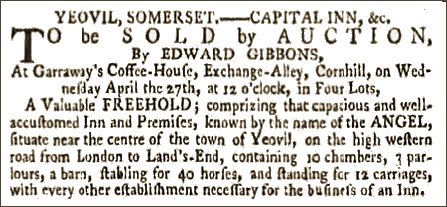the history of yeovil's pubs
PUBS HOME PAGE |
PUBS INTRODUCTION |
PUBS BY NAME |
BEERHOUSES |
angel inn
Hendford
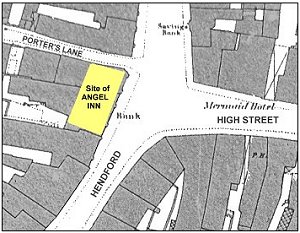 The
Angel Inn once
belonged to the
Chantry of the
Blessed Virgin
Mary Without the
Church,
hence its name
and sign.
The
Angel Inn once
belonged to the
Chantry of the
Blessed Virgin
Mary Without the
Church,
hence its name
and sign.
It stood on the corner of Hendford and Porter's Lane (now Westminster Street) facing High Street and the Borough - the site is now occupied by a bank building.
The 1548 Return of Chantries, recorded that "Alice Evered widow holds by indenture an Inn or tenement called the Angell with a close of pasture containing 2 acres and two pieces of meadow with 3 virgates of arable land also a cottage with a garden and 4 acres and a half of arable land to the same pertaining and renders per annum 66s 8d".
In 1618 an order was made that only nine licensed premises be allowed in the borough (that is the town, not that part of High Street today called the Borough) and two outside, with the rest being 'suppressed'. The Angel Inn was undoubtedly one of the nine 'allowed' premises.
The Angel Inn was an important coaching inn for both London and Bristol travellers, indeed for several centuries it was the principal coaching inn of Yeovil. It was described as a fine building with an arched entrance with a triple window over, above which stood a lead figure of an angel that now resides in Yeovil's Community Heritage Access Centre, together with the carved panel, both being illustrated below.
Few of the early licensees are known; in 1548 Alice Evered, a widow, is recorded as holding by indenture the inn or tenement called the Angel, with a close of pasture containing two acres and two pieces of meadow with three virgates of arable land, and rendered per annum 66s.8d.
|
The name of another licensee appears on a farthing trade token from my collection. The token seen here is magnified as the original is only about 12mm in diameter and 0.5mm thick. It is from the Angel and dated 1652, the earliest recorded for Yeovil. It depicts an Angel in the centre of the obverse, together with the licensee's name, 'Nathaniell Carye'. On the reverse is inscribed 'of Yeavell - 1652 - C.N.A.'. Tokens usually had three initials, representing the two Christian names of the issuer and his wife plus their surname. |
 |
No copper coinage was minted during the Commonwealth and the resulting paucity of small coinage was met by these independently-produced and completely unauthorised tokens of brass or latten (a copper alloy similar to brass). Most Yeovil trade tokens were issued by tradesmen following the death of Charles I in 1649 in order to overcome the lack of small change in general circulation. From 1672 farthings were minted again, in the reign of Charles II, with the consequent demise of trade tokens.
The Angel Inn was completely destroyed by fire, probably in the Great Fire of Yeovil in 1637, after which it was rebuilt.
In 1654 a petition was made in Yeovil against the vicar, the Reverend William Parsons "...Mr Parsons and his wife, and one Mr Jordan and his wife, of Yeavill, with one that had been a Cavalier trooper continued drinking at the Angell in Yeaville until almost seven o'clock at night and departing from thence went to the house of the said Jo: Jordan where one of them fell downe almost dead with drinkinge. That the sayd Mr Parsons with Mr Windham of Trent, Sir Thomas Mallet's sonnes and ye sonne of ye Ld. Sandys being all great Cavileers went to the Angell in Yeovill and there stayed from nine of the clock in the morning until three or fower in the afternoon drinkinge and had musick with them". (see Documentation below).
 In
his book of 1724
"A Tour Thro'
the Whole Island
of Great
Britain; From
London to Land's
End" Daniel
Defoe recalled
the following
tale concerning
the Angel Inn
"There lived a
good substantial
family in the
town not far
from the Angel
Inn - a
well-known
house, which was
then, and, I
suppose, is
still, the chief
inn of the town.
In
his book of 1724
"A Tour Thro'
the Whole Island
of Great
Britain; From
London to Land's
End" Daniel
Defoe recalled
the following
tale concerning
the Angel Inn
"There lived a
good substantial
family in the
town not far
from the Angel
Inn - a
well-known
house, which was
then, and, I
suppose, is
still, the chief
inn of the town.
This family had a dog which, among his other good qualities for which they kept him (for he was a rare house-dog), had this bad one - that he was a most notorious thief, but withal so cunning a dog, and managed himself so warily, that he preserved a mighty good reputation among the neighbourhood.
As the family was well beloved in the town, so was the dog. He was known to be a very useful servant to them, especially in the night (when he was fierce as a lion; but in the day the gentlest, lovingest creature that could be), and, as they said, all the neighbours had a good word for this dog. It happened that the good wife or mistress at the Angel Inn had frequently missed several pieces of meat out of the pail, as they say - or powdering-tub, as we call it - and that some were very large pieces. It is also to be observed the dog did not stay to eat what he took upon the spot, in which case some pieces or bones or fragments might be left, and so it might be discovered to be a dog; but he made cleaner work, and when he fastened upon a piece of meat he was sure to carry it quite away to such retreats as he knew he could be safe in, and so feast upon it at leisure. It happened at last, as with most thieves it does, that the inn-keeper was too cunning for him, and the poor dog was nabbed, taken in the fact, and could make no defense. Having found the thief and got him in custody, the master of the house, a good-humoured fellow, and loth to disoblige the dog's master by executing the criminal, as the dog law directs, mitigates his sentence, and handled him as follows:- First, taking out his knife, he cut off both his ears; and then, bringing him to the threshold, he chopped off his tail. And having thus effectually dishonoured the poor cur among his neighbours, he tied a string about his neck, and a piece of paper to the string, directed to his master, and with these witty West Country verses on it:-
To my honoured
master, - Esq.
Hail master a
cham a' com hoam,
So cut as an
ape, and tail
have I noan,
For stealing of
beef and pork
out of the pail,
For thease
they'v cut my
ears, for th'
wother my tail;
Nea measter, and
us tell thee
more nor that
And's come there
again, my brains
will be flat."
In 1761 gentleman Edward Forbes, proprietor of the Angel Inn, was the proud owner of a celebrated 'museum' in the kitchen of the inn (for full description see Documentation below). Included among Mr Forbes' curiosities was a panel now housed in the Community Heritage Access Centre at Lufton. It is of painted and gilded gesso on oak boards.
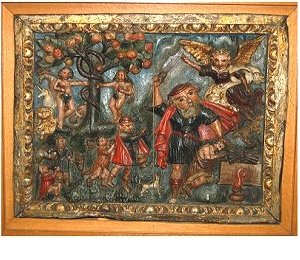 The carved and
coloured panel,
photographed at
left, is thought
to be 17th
century and is
possibly
attributed to
Humphry Beckham
(1588-1671). It was
once hung up in
the kitchen of
the Angel Inn as
part of Mr
Forbes'
'museum'. It
depicts Old
Testament scenes
of Adam and Eve
in the top left
corner, while
the remainder is
devoted to the
story of Abraham
and Isaac. Adam
and Eve are
depicted holding
nine leaves in
front of them
while a serpent
entwines the
apple tree under
which they
stand. Eve
offers an apple
to Adam, who is
about to accept
it. On his right
are a stag, a
unicorn and a
lion, while
below his bent
left knee is an
elephant. In the
lower part of
the panel is the
beginning of the
Abraham and
Isaac story.
Abraham's 'two
young men' are
seen with an
ass, the
standing figure
holds a staff
while the seated
figure drinks
from a flagon.
Towards the
centre Abraham
is seen carrying
a fire-pot while
Isaac follows
carrying a
faggot of
firewood over
his shoulder. In
front of them is
a small white
dog. The right
half of the
panel shows
Abraham about to
sacrifice his
son, Isaac, but
his knife is
held back by the
angel above.
Isaac kneels
before an altar
of faggots with
the fire-pot,
issuing flames,
in front of it.
In the
background is
seen 'the ram
caught in a
thicket by his
horns'.
The carved and
coloured panel,
photographed at
left, is thought
to be 17th
century and is
possibly
attributed to
Humphry Beckham
(1588-1671). It was
once hung up in
the kitchen of
the Angel Inn as
part of Mr
Forbes'
'museum'. It
depicts Old
Testament scenes
of Adam and Eve
in the top left
corner, while
the remainder is
devoted to the
story of Abraham
and Isaac. Adam
and Eve are
depicted holding
nine leaves in
front of them
while a serpent
entwines the
apple tree under
which they
stand. Eve
offers an apple
to Adam, who is
about to accept
it. On his right
are a stag, a
unicorn and a
lion, while
below his bent
left knee is an
elephant. In the
lower part of
the panel is the
beginning of the
Abraham and
Isaac story.
Abraham's 'two
young men' are
seen with an
ass, the
standing figure
holds a staff
while the seated
figure drinks
from a flagon.
Towards the
centre Abraham
is seen carrying
a fire-pot while
Isaac follows
carrying a
faggot of
firewood over
his shoulder. In
front of them is
a small white
dog. The right
half of the
panel shows
Abraham about to
sacrifice his
son, Isaac, but
his knife is
held back by the
angel above.
Isaac kneels
before an altar
of faggots with
the fire-pot,
issuing flames,
in front of it.
In the
background is
seen 'the ram
caught in a
thicket by his
horns'.
The inn was sold in 1791 and the sale details (see gallery below) described the inn as having ten chambers, three parlours, a barn, stabling for 40 horses and standing for 12 carriages plus "every other establishment necessary for the business of an Inn."
The images below, scanned from an old book, show the Borough in a painting of 1810 looking towards Middle Street. The building at right on columns is the old Market House (removed in 1849) the roof supported by columns that covered the butchers' stalls. The Market House also housed the town's stocks whose final occupant was a local man, found to be drunk on a Sunday afternoon and made to sit for hours in the stocks in 1846. (An Act of 1606 imposed a fine of five shillings or six hours in the stocks for drunkenness).
To the immediate left, in the far background at the end of High Street, is seen the Angel Inn with its projecting front bay with arched entrance at ground level and a three-light window over and what appear to be large windows either side of the projecting bay. The lead figure of the angel stood in a niche above the triple window.
The Angel was certainly operating in 1798, but was demolished at the turn of the 19th century when Whitmarsh and White opened a bank on the site in 1808. This was succeeded by Stuckey's bank on the same site in 1835 and the present Westminster bank was opened in today's building in 1919. For more information see the text three photographs down.
gallery
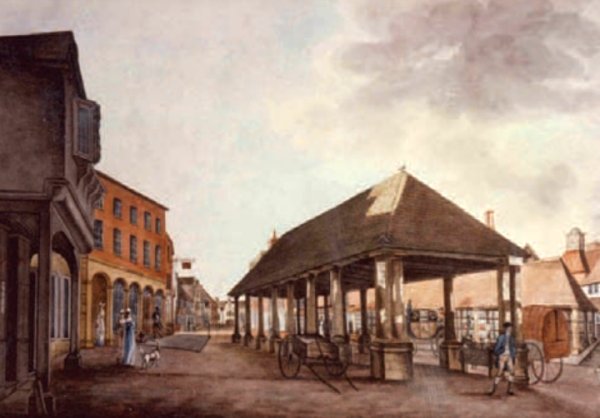
This painting
features in my
book 'Secret
Yeovil'
A painting made in 1810 of the Borough looking towards High Street which runs to the distance at left. The Angel Inn is clearly seen in the distance with its archway and triple window over. The building at left with the arches was, at the time, the ironmongery and cutlery business of William Edwards, taken over around 1827 by Josiah Hannam followed by James Bazeley Petter and then Hill & Sawtell. This is the only building in the Borough that survives to this day, it is now Superdrug.

A colourised enlargement of the previous 1810 image showing the Angel Inn at centre.
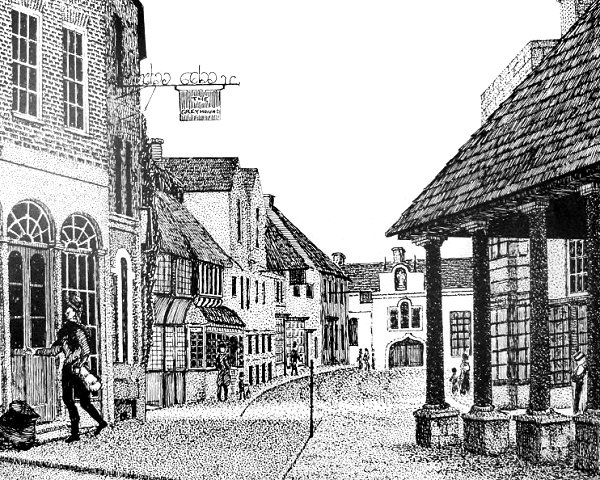
This drawing, by Leslie Brooke based on the above painting, makes clearer the Angel Inn at the far end of High Street, in Hendford, with the figure of the angel at high level.
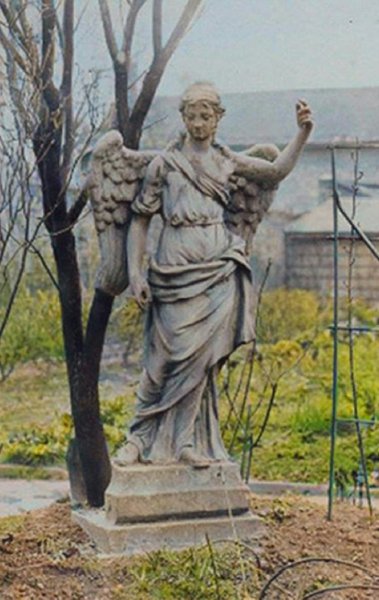
The lead angel, in a colourised photograph of 1910, long before its unfortunate white and gold paint job.

This postcard of around 1925, and looking along High Street to Westminster Street, shows three pubs and the site of the Angel - at extreme left is the Fleur-de-Lys with its sign projecting over the pavement. Opposite, at right of photo, is the Mermaid Hotel with its lovely round-arched entrance and fine Venetian window. In the far distance, at the end of Westminster Street, is the tower of Seaton’s Garage (demolished and now Tesco’s car park) and immediately in front and slightly right is the Heart of Oak. Notice, at the centre of the T-junction, the traffic cop with white cuffs waiting for the rush hour traffic and behind him and the parked roadster is the large building, now a bank, that was built on the site of the Angel Inn.
The April 2023 Hendford Excavation - A Time Team Special
The following series of five photographs show the excavation in Hendford, in front of the Westminster Bank, during April 2023. Bearing in mind the location and the structural construction (described below), I believe the excavation has revealed the last remaining part of both the Angel Inn and the cellar wall of the later Stuckey's Bank.
The Yeovil branch of Stuckey's Bank operated in the old Whitmash & White bank building next to the old Angel Inn in Hendford. But, to quote Vickery "In a few years the premises became too confined for properly carrying on the increasing business of the establishment; and the company, having previously purchased the adjoining property, including the site of the Old Angel Inn, and thrown back its frontage several feet, after compensation from the Town Commissioners, on the 8th of June 1844."

This photograph, with Hendford running off to the left, shows the excavation some six feet away from the front wall of the Westminster Bank, exposing stonework of what I believe to be the front wall of the Angel Inn's cellar and brickwork of the front wall of the cellar of Stuckey's Bank. Photographed in April 2023.
In the gap between the red barriers are seen stonework to the left, brickwork in the middle and the iron gate to the left - all seen in greater detail below.
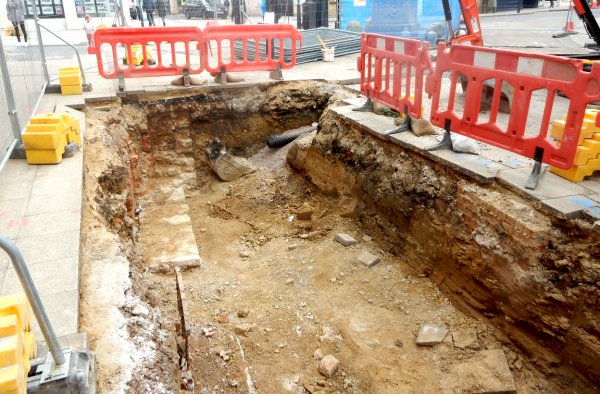
This photograph shows the excavation looking the other way, towards Princes Street, with the excavated walls enlarged below. Photographed in April 2023.

An enlargement of the previous photograph, this shows the remains of a stone wall which I believe to be the external cellar wall of the Angel Inn with, to its left, the remains of brickwork which I believe relate to the cellar of the later Stuckey's Bank (not its external wall above ground, which was closer to the line of the present Westminster Bank building). Photographed in April 2023.

A close-up of the southern (Hendford) end of the trench showing, at the left, a substantial stone wall with what appear to be a course of thin medieval red bricks - the external wall of the old Angel Inn. At the centre is a wall of relatively modern red bricks, which I believe is part of the cellar wall of Stuckey's Bank.
To the right is the metal gate. This is pure conjecture on my part, but could this be the other end of the tunnel from the cellar of the Mermaid Hotel to the Angel Inn? (see below). Photographed in April 2023.

A direct view of the metal gate guarding the now-blocked access to the cellar of the Angel Inn. Photographed in April 2023.
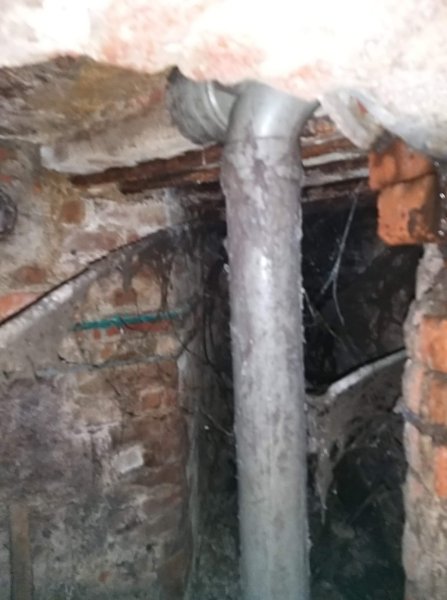
Courtesy of
Catrina
Southword
This tunnel, seen from the Mermaid's cellar, runs under High Street towards what is now the Westminster Bank. It is blocked further along and presumably originally ran to the old Angel Inn in Hendford, that faced High Street.
owners / tenants / licensees
1548 – Alice
Evered, a widow
(from indenture)
1564 – Alice
Evered, a widow
(from indenture)
1587 – William
Trunion
(Churchwardens
Accounts)
1591 – William
Forde (Will of
William Forde)
Forde was a
Churchwarden
(1573) and
played the
part of
Robin Hood
(1575). He owned
farmlands in
Yeovil, Kingston
and Pitney.
1652 –
Nathaniell Carye
(from a dated
token)
1694 – Mrs King
(Yeovil Poor
Rate Book)
1724 –
William Forbes
- Owner
1761 –
Edward Forbes
- Owner (see
Documentation
below). Forbes
died in 1770
aged 70.
1774 – George
Griffiths -
Landlord -
declared
bankrupt in
August 1775.
1775 –
Bani John
Forbes -
Owner (see
report below)
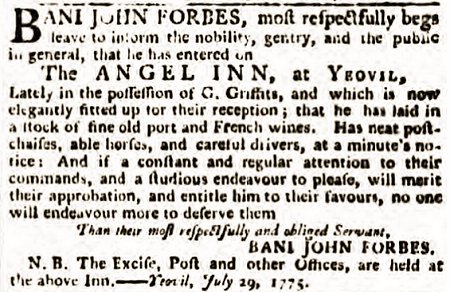
Bath Chronicle &
Weekly Gazette -
7 September 1775
1784 – Mr Francis
- Landlord (see
report
below)
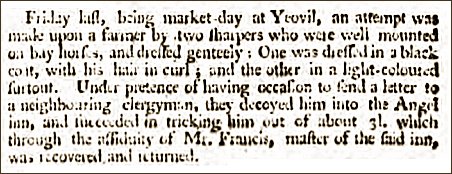
Bath Chronicle &
Weekly Gazette -
12 August 1784
"Friday last, being market-day in Yeovil, an attempt was made upon a farmer by two sharpers who were well mounted on bay horses, and dressed genteely: One was dressed in a black coat, with his hair in curl; and the other in a light-coloured surcoat. Under pretence of having occasion to send a letter to a neighbouring clergyman, they decoyed him into the Angel inn, and succeeded in tricking him out of about £3 which through the assiduity of Mr Francis, master of the said inn, was recovered and returned.
documentation
|
1548 |
Alice Evered, widow, holds by indenture, an Inn or
tenement
called
the
Angell,
with a
close of
pasture
containing
ij acres
and two
pieces
of
meadow
with iij
virgates
of
arable
land,
also a
cottage
with a
garden
and iiij
acres
and a
half of
arable
land to
the same
pertaining,
and
renders
per ann
lxvj s.
viij d.
|
|
1564 |
Alice Evererd, widow, by indenture an Inn or
tenement
called
the
Angel in
Hynford,
1 close
and 2a.
arable
at
Elston,
1a at
Doghill,
½a. at
Florelmore,
½a. at
Le Newe
Meade, 2
plots
meadow
and
curtilages
at
Fourdbridge
with 3
virgates
arable
at
Huish,
3a.
arable
above
Huish at
Netherfurlong,
1
cottage,
gardens
and
adjacent
cottage
, 4a.
arable
at
Northover,
½ acre
arable
at
Anstrak,
part of
1a. in
Dogwill
with all
and
singular
appurtenences
demised
by
Thomas
Waterson
and
heirsd
to
Thomas
Sebright
for 40
years on
1 April
1524, £3
6s. 8d.
...
|
|
1587 |
Sale of Seats - of William Trunion of the Angel
for a
Sete
that was
old
Wilses
of Codd
and
Edmuind
Willes...
2s. 6d.
|
|
1591 |
Will of William Forde, 23 May 1591 |
|
1637-42 |
Richard Lockett of Yeovil, gent, patron of West
Monkton,
1662,
was
party to
a
lengthy
Chancery
suit,
1637-42
in
connection
with
certain
lands,
etc., in
Yeovil
and
Henford,
Somerset,
to which
he
claimed
to be
entitled
jure
uxoris,
who
inherited
the same
from her
grandfather,
William
Ford of
Marsh,
in the
parish
of
Yeovil
(will
dated 31
May 1591
- see
above).
The suit
principally
concerned
an inn
called
the
'Angel'
in
Yeovil
upon
which
Richard
Lockett
declared
he spent
the sum
of £500
in
repairs
and
which
was
totally
destroyed
by fire.
He
married
Mary,
daughter
and
co-heir
of
Thomas
Ford,
the
elder,
of
Yeovil,
marriage
settlement
dated 20
February
1635,
Rev
Giles
Lockett
being
one of
the
trustees.
She died
c1634-5.
They had
issue
John
Lockett,
who died
an
infant
c.1637. |
|
1652 |
Trade token: |
|
1653 |
For that this Court is informed by the Constables,
churchwardens
and
overseers
and
major
part of
the
parishioners
of the
towne of
Yeovill
that a
house
built by
Mr Cary
of the
Angell
at
Yeovill
now
licensed
to sell
ale is a
most
unfitt
place
both in
regard
of the
inconveniences
of the
place as
also for
the
resort
of men's
servants
and
other
idle
persons
travelling
that
way,
whereby
many of
ye
neighbours
are much
prejudiced.
This
Court
doth
hereuppon
order
that the
said
alehouse,
now
called
the
Ship,
shalbe
actually
suppressed,
any
license
formerly
graunted
to the
contrary
notwithstanding.
|
|
1654 |
Extracts: That the said Mr William Parsons is a
man of
scandalous
life and
behaviour,
a
frequenter
of
taverns
and
alehouses...
10thly.
That
about
one of
the
clock in
an
afternoon
about a
year
since,
the
sayde Mr
Parsons
and his
wife and
one Mr
Jordan
of
Yeovill
, with
one that
had
beene a
cavileere
Trooper
continued
drinking
at the
Angell
in
Yeaville
until
almost
seven
o'clock
at night
and
departing
from
thence
went to
the
house of
the said
Jo:
Jordan
where
one of
them
fell
downe
almost
dead
with
drinkinge...
13thly
That the
said Mr
Parsons
with Mr
Windham
of
Trent,
Sr.
Thos.
Mallett's
sonne,
and ye
sonne of
ye Lord
Sands
being
all
grerat
Cavilleers,
went to
the
Angell
in
Yeovill
& there
stayed
from
nine of
the
clock in
the
morniong
untill
three or
fower in
the
afternoon
drinking
and had
musick
with
them...
|
|
1694 |
HENFORD - Mrs King for the Angel, 1s.
|
|
1738 |
This is to give Notice - That there is now at the
Angel
Inn in
Yeovil,
a
thorough
bred
beautiful
young
Stone-Horse,
begot by
a famous
Horse of
my Lord
Godolphin's,
bred by
Sir
William
Morgan,
at
Tredegar
in
Wales,
out of a
thorough
bred
Mare. He
is of a
Brown
Bay
Colour,
with a
black
mane and
Tail,
four
Years
old,
upwards
if
Fifteen
Hands
high,
and will
cover
this
Season
for half
a Guinea
in Hand
for the
Stint,
and one
Shilling
the Man
that
leads
him out.
|
|
1761 |
The Angel Inn is celebrated over this County for
its
Kitchen,
a large
room
originally
intended
for ye
purpose,
but by
ye
present
Landlord,
Mr
(Edward) Forbes, furnish't
with the
greatest
variety
of
curiosities,
rare
china,
and
earthen
ware
painted
with
different
subjects,
many
American
weapons
and
Animals,
models
of ships
and ye
Holy
Sepulchre,
various
English
Fossils
and
other
natural
curiosities,
Lava
from
Vesuvius,
Lamps
from
Herculaneum,
etc.,
etc.
Against
ye Grate
which is
in ye
proper
form but
extremely
neat is
fixt ye
portait
of an
old
Serjeant,
an
Acquaintance
of Mr
F's on
horseback.
To keep
up ye
appearance
of a
Kitchen
there is
pewter
and
other
parts of
Kitchen
Furniture
about
it, and
some
closets
to serve
as
pantries,
but ye
work is
done in
a back
Kitchen.
Here are
also two
large
tables
of a
beautiful
but
coarse
yellow
marble
sprinkled
with
different
coluirs,
spots
and
veins,
dug out
of a
neighbouring
field of
Mr F's,
some
coarser
blocks
of ye
same are
cut into
steps.
The
Landlord
discovers
very
little
appearance
of his
profession
and his
whole
delight
consists
in the
singular
room.
The
business
is
principally
carried
on by
his
nephew
who is
to be
his
heir.
|
| 1777 |
 Letting details of the Angel Inn, from the Bath Chronicle of 18 September 1777 |
|
1779 |
The Angel Inn was
advertised
as
'famed
for its
beautiful
kitchen
and
repository
of
curiosities'.
|
| 1791 |
Sale details of the Angel Inn, from the Bath Chronicle of 21 April 1791. |
